 Operation and Maintenance
Operation and Maintenance
 Windows Operation and Maintenance
Windows Operation and Maintenance
 How to configure the firewall for remote connections to Windows instances
How to configure the firewall for remote connections to Windows instances
How to configure the firewall for remote connections to Windows instances
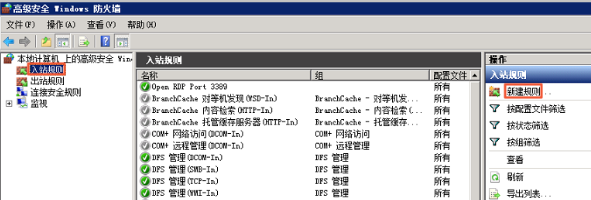
Overview
This article mainly introduces how to configure the remote connection firewall of Windows instances.
Details
#In order to improve the security of remote connection instances, it is recommended that you enable and configure the firewall. We provide you with the following Two options for configuring the remote connection firewall.
#Add port rule
#Add predefined Rules
Add port rules
Allow remote connections by allowing the local remote desktop port. The default port of the remote server is port 3389 of the TCP protocol.
Tip: In the inbound rules of the firewall, if the port set is inconsistent with the port set by the remote server, remote access to the server will not be successful. Once this happens, you can also add the actual port of the remote service to the firewall's inbound rules via this method.
1. Log in to the Windows instance. For how to log in, see Connecting to the Windows Instance on a Local Client.
2. Select Start > Run in the menu bar.
3. In the Run window, enter wf.msc. Click OK.
4. In the pop-up Advanced Security Winodws Firewall window, click Inbound Rules, and then click New Rule.
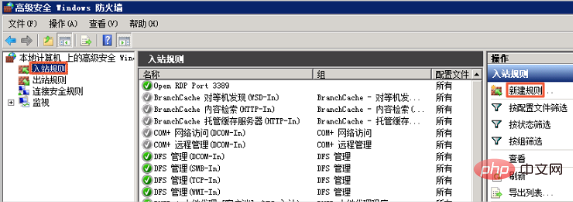
5. In the pop-up New Inbound Rule Wizard window, select the port and click Next.
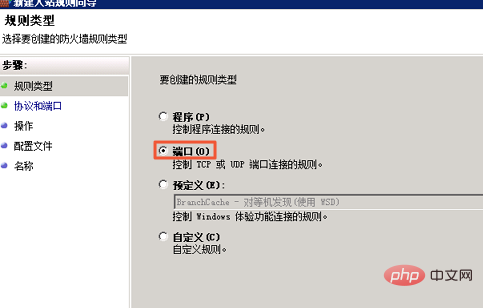
6. In the pop-up window, select TCP and then add a specific local port. Click Next.
Tip: Please refer to the actual remote port for this port. Generally, the default is port 3389.
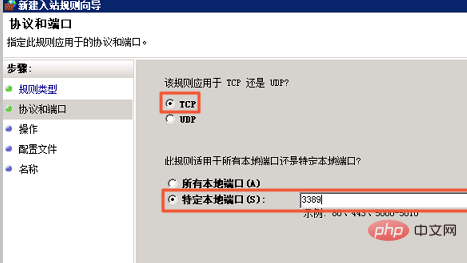
7. In the pop-up window, select Allow connection. Click Next.
8. In the pop-up window, just use the default configuration. Click Next.
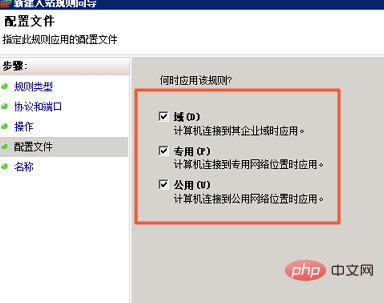
#9. In the pop-up window, fill in the rule name. Click Finish.
10. Check the Windows Firewall properties to confirm whether the firewall is enabled.
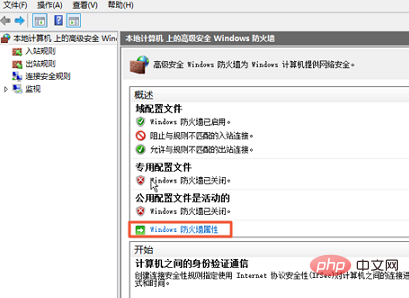
11. If the firewall is not enabled, select Enable (recommended).
Tip: It is recommended to enable all firewalls under the Domain Configuration File, Private Configuration File, and Public Configuration File tabs.
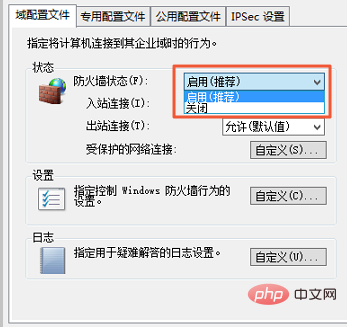
#12. After the above steps are completed, access the server remotely and add a new remote port number after the remote address to connect to the instance. For example: 192.168.1.2:3389.
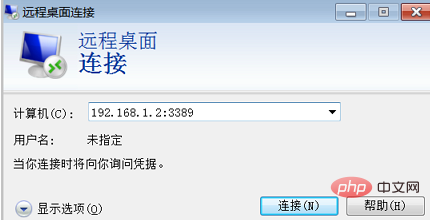
Add predefined rules
By adding predefined "Remote Desktop" for inbound rules Related rules allow remote desktop access.
Tip: This method is suitable for situations where the remote desktop port has not been changed and TCP 3389 port is used by default.
1. Log in to the Windows instance. For how to log in, see Connecting to the Windows Instance on the Local Client.
2. Select Start > Run in the menu bar.
3. In the Run window, enter wf.msc. Click OK.
4. In the pop-up Advanced Security Winodws Firewall window, click Inbound Rules, and then click New Rule.

5. In the pop-up New Inbound Rule Wizard window, select Pre In Define Remote Desktop, click Next.
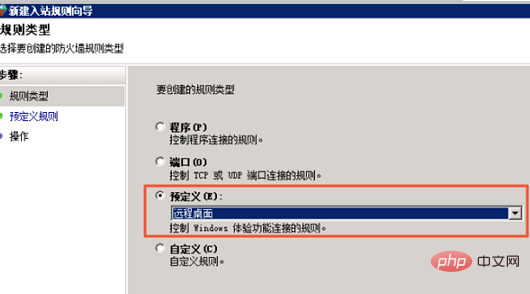
6. In the pop-up window, check Remote Desktop (TCP-In) and click Next.
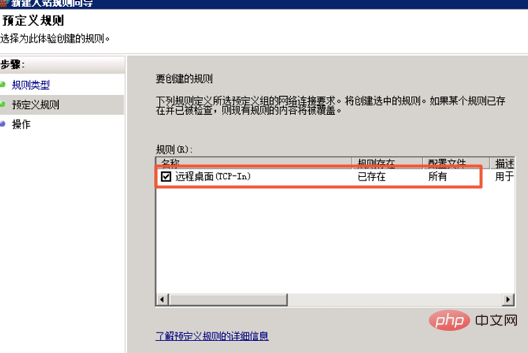
##7. In the pop-up window, check Allow connection and click Finish.
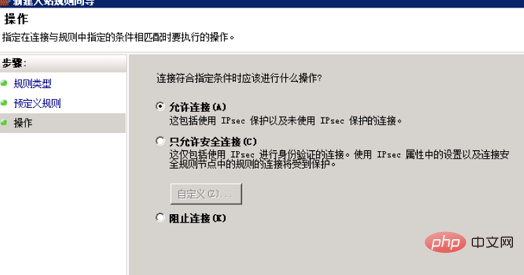
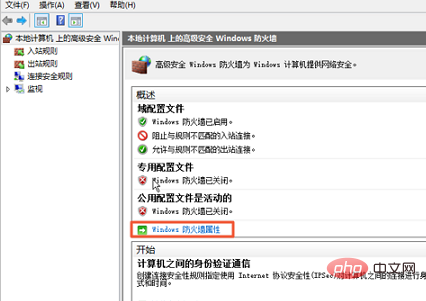
Tip: It is recommended to enable all firewalls under the Domain Configuration File, Private Configuration File, and Public Configuration File tabs.
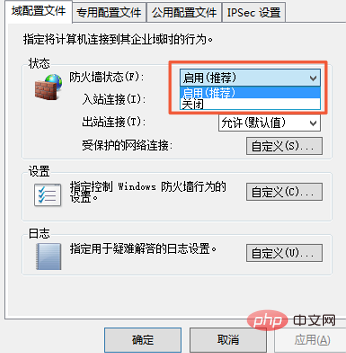 #10. After the above steps are completed, access the server remotely and add a new remote port number after the remote address to connect to the instance. For example: 192.168.1.2:3389.
#10. After the above steps are completed, access the server remotely and add a new remote port number after the remote address to connect to the instance. For example: 192.168.1.2:3389.
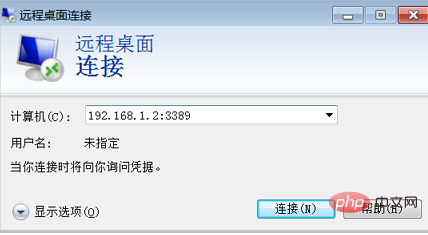
Applicable to Cloud Server ECS
Recommended tutorial:
The above is the detailed content of How to configure the firewall for remote connections to Windows instances. For more information, please follow other related articles on the PHP Chinese website!

Hot AI Tools

Undresser.AI Undress
AI-powered app for creating realistic nude photos

AI Clothes Remover
Online AI tool for removing clothes from photos.

Undress AI Tool
Undress images for free

Clothoff.io
AI clothes remover

AI Hentai Generator
Generate AI Hentai for free.

Hot Article

Hot Tools

Notepad++7.3.1
Easy-to-use and free code editor

SublimeText3 Chinese version
Chinese version, very easy to use

Zend Studio 13.0.1
Powerful PHP integrated development environment

Dreamweaver CS6
Visual web development tools

SublimeText3 Mac version
God-level code editing software (SublimeText3)

Hot Topics
 1384
1384
 52
52
 Can I install mysql on Windows 7
Apr 08, 2025 pm 03:21 PM
Can I install mysql on Windows 7
Apr 08, 2025 pm 03:21 PM
Yes, MySQL can be installed on Windows 7, and although Microsoft has stopped supporting Windows 7, MySQL is still compatible with it. However, the following points should be noted during the installation process: Download the MySQL installer for Windows. Select the appropriate version of MySQL (community or enterprise). Select the appropriate installation directory and character set during the installation process. Set the root user password and keep it properly. Connect to the database for testing. Note the compatibility and security issues on Windows 7, and it is recommended to upgrade to a supported operating system.
 How to speed up the loading speed of PS?
Apr 06, 2025 pm 06:27 PM
How to speed up the loading speed of PS?
Apr 06, 2025 pm 06:27 PM
Solving the problem of slow Photoshop startup requires a multi-pronged approach, including: upgrading hardware (memory, solid-state drive, CPU); uninstalling outdated or incompatible plug-ins; cleaning up system garbage and excessive background programs regularly; closing irrelevant programs with caution; avoiding opening a large number of files during startup.
 In front-end development, how to use CSS and JavaScript to achieve searchlight effects similar to Windows 10 settings interface?
Apr 05, 2025 pm 10:21 PM
In front-end development, how to use CSS and JavaScript to achieve searchlight effects similar to Windows 10 settings interface?
Apr 05, 2025 pm 10:21 PM
How to implement Windows-like in front-end development...
 How to pull the vertical reference line of PS
Apr 06, 2025 pm 08:18 PM
How to pull the vertical reference line of PS
Apr 06, 2025 pm 08:18 PM
Pull vertical guides in Photoshop: Enable ruler view (View > ruler). Hover the mouse over the vertical edge of the ruler, and then the cursor becomes a vertical line with double arrows and hold and drag the mouse to pull out the reference line. Click Delete by dragging the guide, or hovering it into a cross.
 Solutions to the errors reported by MySQL on a specific system version
Apr 08, 2025 am 11:54 AM
Solutions to the errors reported by MySQL on a specific system version
Apr 08, 2025 am 11:54 AM
The solution to MySQL installation error is: 1. Carefully check the system environment to ensure that the MySQL dependency library requirements are met. Different operating systems and version requirements are different; 2. Carefully read the error message and take corresponding measures according to prompts (such as missing library files or insufficient permissions), such as installing dependencies or using sudo commands; 3. If necessary, try to install the source code and carefully check the compilation log, but this requires a certain amount of Linux knowledge and experience. The key to ultimately solving the problem is to carefully check the system environment and error information, and refer to the official documents.
 Unable to access mysql from terminal
Apr 08, 2025 pm 04:57 PM
Unable to access mysql from terminal
Apr 08, 2025 pm 04:57 PM
Unable to access MySQL from the terminal may be due to: MySQL service not running; connection command error; insufficient permissions; firewall blocks connection; MySQL configuration file error.
 How to solve mysql cannot connect to local host
Apr 08, 2025 pm 02:24 PM
How to solve mysql cannot connect to local host
Apr 08, 2025 pm 02:24 PM
The MySQL connection may be due to the following reasons: MySQL service is not started, the firewall intercepts the connection, the port number is incorrect, the user name or password is incorrect, the listening address in my.cnf is improperly configured, etc. The troubleshooting steps include: 1. Check whether the MySQL service is running; 2. Adjust the firewall settings to allow MySQL to listen to port 3306; 3. Confirm that the port number is consistent with the actual port number; 4. Check whether the user name and password are correct; 5. Make sure the bind-address settings in my.cnf are correct.
 MySQL can't be installed after downloading
Apr 08, 2025 am 11:24 AM
MySQL can't be installed after downloading
Apr 08, 2025 am 11:24 AM
The main reasons for MySQL installation failure are: 1. Permission issues, you need to run as an administrator or use the sudo command; 2. Dependencies are missing, and you need to install relevant development packages; 3. Port conflicts, you need to close the program that occupies port 3306 or modify the configuration file; 4. The installation package is corrupt, you need to download and verify the integrity; 5. The environment variable is incorrectly configured, and the environment variables must be correctly configured according to the operating system. Solve these problems and carefully check each step to successfully install MySQL.



